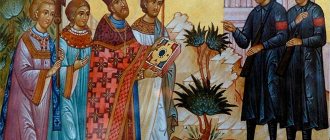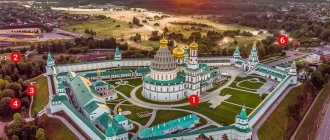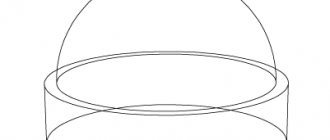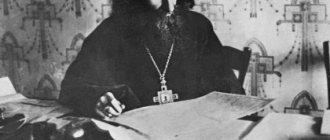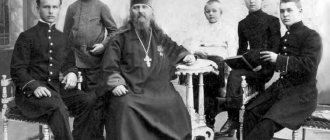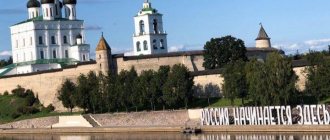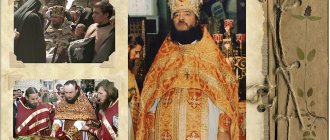| Sylvester (Olshevsky), Bishop of Priluki, vicar of the Poltava diocese. 1911 |
Sylvester (Olshevsky)
(1860 - 1920), Archbishop of Omsk and Pavlodar, spiritual writer, hieromartyr Commemorated on February 13 and in the Councils of New Martyrs and Confessors of Russian and Poltava (Ukr.) Saints
In the world, Iustin Lvovich Olshevsky was born on June 1 [1] 1860 in the family of a deacon in the village of Kosovka [2], Skvirsky district, Kyiv province.
In 1883 he graduated from the Kyiv Theological Seminary. As a student of the seminary, he served as a reader of the famous dogmatist, professor of the KDA, Archimandrite (later bishop) Sylvester (Malevansky). Justin’s duties included reading aloud to the professor, who had poor eyesight, works of theological nature by both domestic and foreign authors.
In 1887 he graduated from the Kyiv Theological Academy with a candidate's degree in theology.
From October 27, 1887, he worked as a teacher at a parochial school in the village of Lipovka, Kyiv district.
On January 15, 1888, he was transferred as a law teacher to a two-year ministerial school in the town of Shpola, Kyiv district. The town of Shpola, one of the poorest in the province, was almost entirely infected with Stundism. Having thoroughly studied the teachings of the sect, Justin Lvovich came to the idea that the activities of a secular missionary could bring more fruit than a missionary from the clergy. He outlined his thoughts on this matter in writing and submitted a memorandum to Metropolitan Platon (Gorodetsky) of Kyiv; these considerations were fully accepted, and on March 7, 1889, Justin Lvovich was appointed missionary of the Kyiv diocese and teacher of the parochial school of the St. Vladimir Brotherhood. At that time, the appointment of a secular person to this position was very rare, which required outstanding qualities from the missionary. The result of Justin Olshevsky’s practical work in the field of educating sectarians was his work “Condemning the Shtunda in Biblical Texts”; this work became a most valuable guide for missionaries and was reprinted several times.
Since 1890 - Poltava diocesan missionary and teacher of theological seminary in history, pastoral theology, liturgics and homiletics.
As a well-proven and experienced missionary, Justin Lvovich was sent in June 1891 to the 2nd Missionary Congress in Moscow.
When Justin Lvovich was offered to accept the rank of presbyter, he agreed to accept it on the condition that he remain unmarried. The Holy Synod gave permission for this.
In 1892 he was ordained to the rank of deacon.
On February 2, 1892, he was ordained presbyter at the Poltava Cathedral.
From October 1892 to 1896, he acted as head and teacher of the law for the women's Sunday school in the mountains. Poltava.
Since 1896 - diocesan observer of church schools of the Poltava diocese.
On May 12, 1902, he was elevated to the rank of archpriest.
The diocesan authorities, highly appreciating the merits of Archpriest Justin, repeatedly offered him the rank of bishop, but out of his humility, he refused each time. On December 10, 1910, Archpriest Justin was appointed Bishop of Prilutsk with tonsure as a monk
On December 23, 1910, he was tonsured a monk and on December 25, he was elevated to the rank of archimandrite by Archbishop Nazariy (Kirillov) of Poltava.
On January 16, 1911, he was consecrated Bishop of Priluki, vicar of the Poltava diocese in the Holy Trinity Cathedral of the Alexander Nevsky Lavra. The rite of consecration was performed by: Metropolitan Vladimir (Epiphany) of Moscow, Metropolitan Flavian (Gorodetsky) of Kiev with other bishops.
Since November 13, 1915 - Bishop of Chelyabinsk, vicar of the Orenburg diocese.
Since June 4, 1915 - Bishop of Omsk and Pavlodar.
He was a participant in the Local Council of the Russian Orthodox Church in 1917-1918.
In January 1918 he returned to Omsk. On February 4, 1918, he led a grand religious procession through the streets of the city. Walking through the streets of the city, the grandiose religious procession stopped at each church, the bishop served a prayer service, and then addressed the people with a word of exhortation, calling on them to preserve the Orthodox faith and protect the churches, which, with the advancing order, were threatened with ruin.
A day after the city religious procession, at three o’clock in the morning from February 5 to 6, an armed detachment of punitive sailors approached the bishop’s house, and the sailors began knocking on the doors of the house. Since long before that night, the Reverend Sylvester, in view of the robberies and violence carried out in the city under the guise of searches, ordered that no one should be allowed into the house at night, the servants did not open the doors. Those who came began to threaten that they would shoot and blow up the doors. Then, by order of the housekeeper of the bishop's house, the alarm bell was rung in the cathedral bell tower. The punishers fled. People began to come running to the bishop's house, and the bishop came out to them. At this time it became known that some people were robbing the house of the cathedral archpriest Fr. Alexander Solovyov and the keymaster. Some of the people went to their house. At this time, an armed detachment appeared again and broke into the bishop’s house.
The leader of the detachment attacked the people who were in the bishop's house and, having fired from a revolver, killed the housekeeper of Bishop Nikolai Tsikura with an explosive bullet. The Reverend Sylvester was seized, a revolver was put to his head and, without being given the opportunity to put on warm clothes, he was taken on foot through the Siberian frost to the premises of the Council of Deputies.
On the way to the council of deputies and during the first hours of his stay there, the atheists incessantly mocked the Reverend Sylvester. The bishop was put in a common stuffy and dirty room. At this time, bells were buzzing throughout the city - other churches responded to the ringing of the cathedral bell tower. Crowds of people appeared near churches, on the streets and squares. Outraged people demanded the bishop's release. At the request of the believing townspeople, several deputations were allowed to visit the bishop. The deputations and general popular indignation influenced the mood of the atheists, and the bishop was transferred to another room. The soldiers' swearing began to fade, and then stopped completely. The next day the whole city was in motion; institutions, shops, educational institutions were closed. There was continuous shooting in the city - the Red Guards were dispersing the people with volleys. A guard was posted at the bishop's house. At four o'clock in the afternoon, a state of siege was declared in the city, and people were forced to disperse. The shooting continued all night. At twelve o'clock at night, an investigative commission came to the bishop's house and sealed the bishop's chambers. The bishop spent February 7 in prison, and on the 8th at twelve o’clock in the afternoon he was released.
In 1918, Patriarch Tikhon elevated him to the rank of archbishop on the day of Holy Easter.
Soon the civil war began, and the whites liberated the city from the Bolsheviks. At this time, Omsk, like all of Siberia, found itself cut off from Russia by the front line.
In November 1918, a conciliar meeting of the archpastors of Siberia was held in Tomsk, which organized the Temporary Higher Church Administration of Siberia, the head of which was elected Archbishop Sylvester. He began his activities by canceling the godless decree of January 19, 1918. Land and property were returned to the church, and the teaching of the Law of God was restored in schools. In Siberia, educational activities were restored in five theological seminaries and five theological schools.
When Admiral Kolchak came to power, Archbishop Sylvester swore him in as Supreme Ruler of Russia on January 29, 1919. In March 1919, the archbishop organized a religious procession through the city with the participation of Kolchak and the Kolchak government. In May–June, he made trips to the Tomsk, Krasnoyarsk and Irkutsk dioceses, during which he delivered more than a hundred sermons in various parishes. To strengthen the spirit and morality of the officers and soldiers of the White Army, Archbishop Sylvester restored the institution of military priests, and they sent more than two thousand shepherds to the army. The church administration, headed by the Most Reverend Sylvester, sent out more than sixty thousand appeals, which explained the anti-Christian essence of Bolshevism. The magazines “For Holy Rus'” and “Siberian Blagovestnik” began to be published in Omsk.
In August 1919, a congress of Russian Cossack troops took place in Omsk, at which the Supreme Ruler, Admiral Kolchak, delivered a welcoming speech, calling for the defense of the Orthodox faith, and His Eminence Sylvester blessed the soldiers with banners with the image of a cross and the inscription: “By this victory.”
| Sschmch. Sylvester (Olshevsky) |
At the end of 1919, during the retreat of the White Army from Omsk, he remained with the flock entrusted to him by God and was immediately arrested by the Bolsheviks.
For two months he was tortured by the Cheka, where they demanded “repentance” from him to no avail. On February 26, 1920 he was brutally murdered. Having nailed the saint's hands to the floor, the godless monsters burned his body with red-hot ramrods, and then pierced his heart with a red-hot ramrod. The body of the holy martyr was then secretly buried by the executioners, and the place of burial was unknown until recently.
In 1998, Archbishop Sylvester was canonized as a locally venerated saint of the Omsk diocese.
Canonized as holy new martyrs and confessors of Russia at the Jubilee Council of Bishops of the Russian Orthodox Church in August 2000 for church-wide veneration.
On July 16, 2005, archaeologists discovered the burial of an Orthodox bishop while excavating the foundation of the Assumption Cathedral, which was blown up in 1935, in the very center of Omsk. In the tomb, which was discovered in a secret underground room under the porch of St. Nicholas, an icon, pieces of fabric, body remains and other finds were found, indicating that this was the burial of Archbishop Sylvester. Later, the belonging of the relics to the Archbishop of Omsk and Pavlodar Sylvester was confirmed by the results of the examination.
On February 25, 2009, in the restored Omsk Assumption Cathedral, a shrine with the relics of the holy martyr Sylvester was installed at its permanent location. It is located in the lower aisle of the cathedral, in the so-called cave church, where the holy martyr was buried. The saint's relics are now available for veneration. Especially for the reliquary with the relics of St. Sylvester, a hand-carved wooden canopy was made of cedar and installed on four stone pillars, which became one of the main decorations of the Assumption Cathedral.
Ascetic devotee
| Icon of the Hieromartyr Sylvester of Omsk |
On November 29, 1998, for the first time in the history of the Omsk diocese, canonization took place. Archbishop Sylvester was canonized as a locally revered saint. And in July 2000, at the anniversary Council of Bishops of the Russian Orthodox Church, Saint Sylvester of Omsk was glorified as a new martyr of Russia.
Hieromartyr Sylvester, in the world Justin Lvovich Olshevsky, was born on June 1, 1860 in the village of Kosovka, Kyiv province, into the family of a deacon. While studying at the Kyiv Theological Seminary, he was the “eyes and pen” of Professor Archimandrite Sylvester (Malevansky), helping a blind scientist write scientific works. On the recommendation of the professor, he entered the Kyiv Theological Academy, which he graduated in 1887 among the first with a candidate of theology degree. Having carefully studied the teachings of the Protestant sects that came to Russia from the West, Justin Lvovich chose the path of a missionary. Twenty years of his missionary and pedagogical work were associated with the Poltava diocese. In Ukraine, Sylvester was widely known for his tireless work in the field of spiritual enlightenment. When the bishop was asked if he had children, he replied that he had 50 thousand God-given children - all children of the Poltava diocese.
Following the example of his teacher, who was distinguished by asceticism, Justin Lvovich chose the most modest way of life for himself. He never aspired to possess material wealth and limited himself in everything. He had no property; for many years he lived in a modest cell at the monastery hotel. He devoted all his time to work and prayer. And the summer holidays are for pilgrimages to holy places.
Justin Lvovich Olshevsky took monastic vows with the name Sylvester only at the age of 50. And before that he led the life of a monk in the world. When in 1892, by permission of the Holy Synod, as an exception, he was ordained a priest in his current state, that is, unmarried, the clergy reacted differently to this vital step of the saint. Then, in parishes, outside of monasteries, priests served exclusively from the white clergy. Subsequently, the newspaper Poltava Diocesan Gazette wrote that some distrust over the years was replaced by a feeling of boundless respect. It became clear that Father Justin reveals in his person a shepherd of high Christian spirituality and worldview, a shepherd of exceptional willpower and character. Just as he was once influenced by the example of the high life of the archimandrite, later Bishop Sylvester of Malevansky, so the light of his own daily exploit illuminated the path of Christian service to the young Poltava clergy.
Essays
- Book of the Wisdom of Jesus, son of Sirach // IR NBUV. F. 304. D. 1082.
- Draft instructions for anti-Stundist missionary priests of the South-Western region // Guide for rural shepherds. 1889. - No. 24.
- On the organization of women’s education and training in public schools // Guide for rural shepherds. 1891. - No. 16.
- The objectives of our anti-sectarian mission; Speech at the opening of a Sunday girls' school // Poltava Diocesan Gazette. 1892. - No. 6, 23.
- Archimandrite Makariy Glukharev, founder of the Altai mission // Poltava Diocesan Gazette. 1893. - No. 7.
- The work and activities of the Translation Commission of the Orthodox Missionary Brotherhood // Poltava Diocesan Gazette. 1894. - No. 8.
- Sixth anniversary of the Poltava branch of the Missionary Society.
- Word on the occasion of the opening of the monument // Poltava Diocesan Gazette. 1895. - No. 5, 18.
- Wives of the Evangelist // Poltava Diocesan Gazette. 1896. - No. 4.
- Word on the Day of the Presentation of the Lord; The missionary nature of the parochial school among the sectarian population; Women's church schools; School holiday // Poltava Diocesan Gazette. 1897. - No. 5, 27, 30-32.
- Words before the Holy Shroud on Good Friday // Poltava Diocesan Gazette. 1898. - No. 11/12; 1899. - No. 13; 1904. - No. 12; 1905. - No. 13; 1906. - No. 11; 1908. - No. 15; 1909. - No. 11; 1910. - No. 13.
- Sermon on the 1st Sunday of St. Pentecostals; Word; Speech at the opening of pedagogical courses for teachers // Poltava Diocesan Gazette. 1898. - No. 7, 13, 19.
- Our Transbaikal mission and Lamaism; Celebration of Women's Central Schools; Word to children // Poltava Diocesan Gazette. 1899. - No. 12-13, 18.
- Words in St. Pentecostals; Speech at the opening of pedagogical courses for teachers // Poltava Diocesan Gazette. 1901. - No. 7, 9.
- Words on St. Day Cyril and Methodius; Word on the day of the 100th anniversary of the Poltava diocese // Poltava Diocesan Gazette. 1903. - No. 16; 1904. - No. 1, 15.
- In memory of the Right Reverend Theophan, the Vyshinsky recluse (9 of his letters to the Valaam elder Agapius) // Poltava Diocesan Gazette. 1905. - No. 5-7.
- The place where the Lord lay with the annex of plans of the city of Jerusalem and the city of Poltava // Poltava Diocesan Gazette. 1906. - No. 4-6.
- Words; [Polemical articles] // Poltava Diocesan Gazette. 1907. - No. 7, 14, 21-23; 1908. - No. 2, 9-10, 32, 36.
- The place where the Lord lies. From Palestinian conversations in the Poltava Cathedral. Poltava, 1907.
- Are you in faith? - Poltava, 1909.
- Russian saints from the laity. Theological readings. Poltava, 1909.
- Sermon on the 40th day after the death of Archpriest. John of Kronstadt; 25th anniversary of our central school // Poltava Diocesan Gazette. 1909. - No. 5, 21.
- Fighting the stunda. Poltava, 1910 (3rd ed.).
- Word before the Gorbanevsky image of the Mother of God // Poltava Diocesan Gazette. 1910. - No. 20.
- Denunciation of shtunda in biblical texts. — 2nd ed. - Poltava, 1910.
- God's Law Missionary Program for Primary Schools. (Against sectarians). - Poltava, 1910.
- Speech at the naming of a bishop // Church Gazette. Arr. 1911. - No. 4.
- Shepherd prayer book // Pastoral wreath to dear priest Fr. John of Kronstadt. St. Petersburg, 1911. - pp. 14-20.
- Public theological reading. - Poltava, 1913.
- Ways of salvation. - St. Petersburg, 1913.
- Word at the first entry into the Chelyabinsk Cathedral; What should a choir reading be like // Orenburg Diocesan Gazette. 1915. - No. 1, 41-44.
- Missionary work in primary school; To the clergy of the Omsk diocese // Omsk Diocesan Gazette. 1915. - No. 19, 22, 24.
- To the clergy of the Omsk diocese; Appeals to the people and clergy; Message to the flock // Omsk Diocesan Gazette. 1917. - No. 7, 12, 15/16, 21.
- To the faithful children of the Omsk flock in Christ // Omsk Diocesan Gazette. 1918. - No. 4/5.
- Word during the service of the funeral liturgy according to Bishop. Hermogen; Healthy channel; Word before the opening of the All-Russian Exhibition Center of Siberia // Tobolsk Diocesan Gazette. 1918. - No. 21/22, 32-34.
- The personal principle in a person and its moral significance; Speeches at the presentation of archpastoral staffs // Tobolsk Diocesan Gazette. 1919. - No. 10-14, 21.
- Eight days with the soldiers in a heated vehicle. Omsk, 1919.
- On the activities of the preaching detachment in the White Army since February 26, 1919 // Bulletin of the Omsk Church. 1919. - No. 5/6.
- Speeches and letters // White Guard. 2008. - No. 10. - P. 77-78, 80-82.
Foresight
Saint Sylvester never raised his voice. Instead of scolding, he could give his subordinates a delicate reproach. It happens that careless workers take advantage of such qualities. This almost never happened to him.
Throughout his life, Saint Sylvester had high authority in a variety of circles. The success of missionary activity depends on the ability to persuade. He was listened to attentively by the Orthodox, those wavering in their convictions, those who had fallen from the faith, schismatic Old Believers, sectarians, and Tolstoyans. After writing works on how educational work should be carried out, Father Justin began to be considered one of the most knowledgeable specialists on this topic in Russia.
Being himself a representative of the intelligentsia, Vladyka, while still a priest, wrote a book for educated people, “Are You in the Faith?”, catching those deep tendencies of spiritual vacillation that led to the collapse of the country. Contemporaries wrote about Saint Sylvester that he was characterized by a charming simplicity of communication, sincerity, and cordial responsiveness. Out of modesty, he refused for a long time the rank of bishop. And when he accepted it, he took it as his duty and cross.
On the day of his consecration as bishop, January 15, 1911, foreseeing the future of the Church and his own destiny, Saint Sylvester said: “Now, more than ever, the Christian Church is like a ship overwhelmed by the great turbulence of the sea of life. For the faithful, the times of confession are coming... Archpastorship is difficult and scary now.”
Siberia. War
| Bishop Sylvester (Olshevsky) |
On June 4, 1915, by Decree of the Holy Synod, His Eminence Sylvester became Bishop of Omsk and Pavlodar. Having a pious habit of praying at renowned shrines before any difficult task or test, the Bishop, before heading to Omsk, made a pilgrimage to Irkutsk, venerated the holy relics of St. Innocent and asked him for help.
The bishop's service in Omsk fell during the difficult time of the First World War and revolution. But how much he managed! He created the Siberian Patericon - biographies of ascetics of the faith. He obtained from the Sovereign Emperor a decision on free education in religious educational institutions for the children of St. George's Knights. In 1917, a royal decree was even issued on the establishment of a scholarship named after His Eminence Sylvester. The Bishop collects funds to help refugees, establishing a diocesan committee for this purpose. Refugees are accommodated in the Pokrovsky and Znamensky monasteries. The Paraskevievskaya and Cathedral schools provided shelter for 200 people. Even in his bishop's house, the saint settled two families - a family of Catholics and a family of a psalm-reader of the Minsk diocese with eight children. He was very kind to people and loved children. In 1915, he opened a shelter for the children of wounded and crippled soldiers, in which novices of the monastery worked. Continuing his missionary service, Bishop Sylvester works in a prisoner of war camp, and about 500 Czechs, Rusyns, and Poles express a desire to convert to Orthodoxy. The Bishop solemnly performs the ceremony of joining non-Orthodox people to our faith in the Assumption Cathedral.
In 1916, great celebrations were held in Tobolsk to glorify Metropolitan John of Tobolsk. Bishop Sylvester took part in them along with his flock, who went to Tobolsk from the Omsk diocese in walking processions of the Cross.
Test time
On February 2, 1917, Bishop Sylvester celebrated his twenty-fifth anniversary of service in the priesthood. He did not want to celebrate the anniversary, but the clergy of the diocese asked permission to celebrate this date. Archpriest of the Assumption Cathedral Fr. Alexander Solovyov, in his congratulatory speech to the hero of the day, called the service of Bishop Sylvester a feat and said: “Christ is your strength, your joy, the goal of your life...” The saint amazed everyone who communicated with him with the strength of his faith and the integrity of his views.
And only a month after the celebration, which took place in a familiar, calm atmosphere, the February Revolution broke out. On March 4, during a sermon during a service in the Assumption Cathedral, Bishop Sylvester informed the flock about the completed coup.
From now on, all the bishop’s concerns are devoted to the pacification of the people. In his sermons, he talks about fulfilling his duty to the Motherland, about external and internal peace, and asks to pray for God’s help to the Provisional Government.
On March 10, 1917, a celebration of civil liberties was held on the square in front of the Assumption Cathedral. The Omsk clergy decided to take part in this event in the name of good and peace. After the liturgy, religious processions from all Omsk churches came to the square. The Bishop addressed the people. After him, representatives of Baptists, Catholics, Jews spoke, and a parade of troops took place. This day demonstrated that in troubled times it is possible to maintain harmony on Omsk land.
Everything changed with the Bolsheviks coming to power. The persecution of the Church began. As soon as the decree on the separation of Church and state was promulgated, the new authorities demanded that Bishop Sylvester transfer to their disposal the building and property of the Spiritual Consistory and even the bishop's house. This happened on February 2, 1918. There was a rumor that they were going to set up an infirmary in the Assumption Cathedral. Archpriest of the Assumption Cathedral Fr. Alexander Solovyov gave a heartfelt sermon on this topic. After the service, a rally began on Cathedral Square, dispersed by the Red Guards. This was the case throughout Russia. At the call of the Local Council, the people responded to the oppression with religious processions.
In Omsk on Sunday, February 4, a message from Patriarch Tikhon was read. The citywide religious procession was led by His Eminence Sylvester. Marching from the Assumption Cathedral through the streets of the city, the grand procession stopped at each church, the bishop served a prayer service, and then addressed the people with an admonishing word, calling on them to preserve the Orthodox faith and protect the churches that were in danger of ruin.
A day later, at three o’clock in the morning from February 5 to 6, an armed detachment under the command of Shebaldin approached the bishop’s house. They started knocking on the doors. The uninvited guests threatened that they would shoot and blow up the doors. And then the alarm bell sounded in the bell tower of the Assumption Cathedral. The bell ringer climbed the bell tower to announce trouble and gather Omsk residents. He was wounded, but his noble impulse was taken up by the bell ringers of other temples. Anxiety spread throughout the city, and, as is customary in times of national trials, people walked and walked, filling the square and the streets around. The punishers fled. The Bishop came out to the people. And then the armed detachment returned and broke into the house. The Bolsheviks, cursing, shouted: “Where is the bishop?” “I am a bishop,” answered the bishop. The Reverend Sylvester was grabbed, a revolver was put to his head, and without being allowed to put on warm clothes, he was taken away. Bishop Nikolai Tsikura, now also glorified among the Russian New Martyrs, was killed with a revolver.
An investigative commission came to the house and sealed the chambers. But the people did not disperse, demanding the release of the bishop. This pressure had an effect. The Reverend Sylvester was released on February 8, having taken a written undertaking not to leave the place. Vladyka immediately gave a telegram to Patriarch Tikhon: “Released. I'm waiting for a revolutionary trial. The people are tied to the Church."
Yes, back then the majority of the people were believers, and the impostors in power were afraid of their indignation. The bishop's prediction about the difficulties of archpastorship came true. In August 1918, he traveled to Tobolsk to take part in the burial of Bishop Hermogenes, who was drowned by the Bolsheviks in the Tobol River...
Colleague of Kolchak
Archbishop Sylvester had high hopes for Alexander Vasilyevich Kolchak. In November 1918, when Siberia became “white,” a conciliar meeting of the archpastors of Siberia was held in Tomsk. Vladyka Sylvester, elevated to the rank of archbishop by Patriarch Tikhon, was elected head of the Higher Provisional Church Administration of Siberia. Thus, the authority of the Omsk bishop and the status of the city as the Third Capital of Russia were again confirmed. The first thing the archbishop did in his new post was to cancel the godless decree of January 19, 1918. Land and property were returned to the church, and five Siberian theological seminaries and five schools resumed their work.
Alexander Vasilyevich Kolchak was a deeply religious man, and he identified the fight against the “Reds” with standing for the Motherland and Orthodoxy. Lord Sylvester perceives his duty and mission in exactly the same way. He blesses the Brigades of the Holy Cross and sends preaching detachments to the front line. They, contrary to the claims of the victorious side in the Civil War, are unarmed. They come with the Cross, prayer and a word addressed to the hearts of the soldiers.
The church administration, headed by His Eminence Sylvester, sent out more than 60 thousand appeals, which explained the anti-Christian essence of Bolshevism. The periodicals “Siberian Blagovestnik” and the magazine “For Holy Rus'” began to be published for the army and the people.
From “white” Omsk, Saint Sylvester tries to defend the Church, which was oppressed in the territory occupied by the Bolsheviks. He appeals to Pope Benedict XI regarding the Soviet persecution of Orthodoxy, trusting in the fraternal unity of Christians, and sends a telegram to the Archbishop of Canterbury.
From the Vatican follows a telegram-incantation on behalf of the head of the Catholics to Lenin to stop the persecution of the servants of God. But the Bolshevik leader had other plans...
The Siberian archpastor also takes part in the admiral’s purely peaceful initiatives. For example, he blesses the Directorate of Lighthouses and Pilots established in Omsk, and serves a prayer service on the occasion of the sailing of a scientific expedition to the North Pole on the steamer “St. Nicholas”.
Literature
- Feodosius (Protsyuk), Metropolitan.
Are you in faith? The life and works of the holy martyr Sylvester, Archbishop of Omsk. - M: Sunday, 2006. - 608 p. - Olikhov D.V.
Creation and activities of the Temporary Higher Church Administration of Siberia // Bulletin of the Omsk Orthodox Theological Seminary. 2021. - No. 1. - P. 72-86. - Sushko A.V.
Participation of the Omsk clergy in the events of the Russian Revolution and the Civil War (on the example of the fate of Archbishop Sylvester (Olshevsky) and priest V.F. Infatyev) // Omsk Scientific Bulletin. Ser. Society. Story. Modernity. 2021. - No. 3. - P. 5-8
Martyr for the Faith
| Archbishop of Omsk and Pavlodar Sylvester. The only surviving Omsk photograph |
When the White Army left Omsk, the bishops who fled the Bolsheviks in Omsk left with it. Probably, Vladyka Sylvester could have left Omsk with the “whites” and survived, finding himself in exile. He knew that nothing good could be expected from the Bolsheviks. He was at the patriarchal elections in the Moscow Kremlin, when the Bolsheviks fired guns at the shrines. He knew and spoke about the already tortured 20 bishops and 1000 clergy, buried Bishop Hermogenes, and himself survived the arrest. But His Eminence Sylvester could not abandon his flock. He understood that flight would be cowardice, and he courageously looked into the eyes of future adversity.
They began as soon as the “Reds” occupied Omsk. The ruler was arrested and tortured for two months in the dungeons of the Cheka. The saint died on January 26, 19 days after the murder of Kolchak.
The cynicism of the new government was that when destroying not only ordinary citizens, but also famous people, the executioners did not leave official evidence. There was a man - and he is not. And not a line in the documents about what was done to him.
Most of the victims of political repression do not have graves; their bodies were dumped in pits and ditches, on the site of which industrial facilities were later built. But the holy martyr Sylvester found his resting place in the temple where his pulpit was. It can be assumed that in 1920 the machine of repression was not yet as streamlined as it was later, in the 1930s, and people from Bishop Sylvester’s entourage somehow miraculously managed to persuade or bribe the prison guards so that the body of the murdered man was given for Christian burial. Everything was done in the strictest secrecy, so that for decades there were no rumors or legends spread in the city about the possible burial place of the archbishop.
Notes
- Hieromartyr Sylvester (undefined)
(inaccessible link). Omsk diocese of the Russian Orthodox Church MP. Retrieved November 25, 2015. Archived November 25, 2015. - Panina M. F.
“They didn’t touch him anymore”: the legend of the martyrdom of Archbishop Sylvester in 1920 // News of the Omsk State Museum of History and Local Lore: Collection of scientific works - No. 19. - Omsk, 2014. - pp. 123-126 . - Khrapova N. S., Sushko A. V.
Actual record of the death of Archbishop Sylvester (Olshevsky): some aspects of source analysis // Civil War in the East of Russia: a look through the documentary heritage: collection. tr. conf. - Omsk: Omsk State Technical University Publishing House, 2021. - P. 299-304. - Kostryukov A. A.
On the issue of the glorification of non-Orthodox Christians by the Russian Church Abroad // Orthodoxy in the Baltics. 2021. - No. 9 (18). — P. 74. - Kostryukov A. A.
The initial list of new martyrs prepared by the Russian Church Abroad for canonization in 1981 // Church and Time. 2020. - No. 2 (91). — P. 51—116. - Months of February 25, 2021 from the Nativity of Christ (Art. Art.) (undefined)
.
Orthodox church calendar for every day |
Orthodoxy and Peace . pravmir.ru (March 10, 2019).


